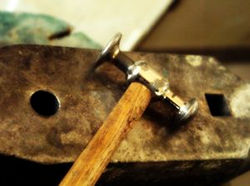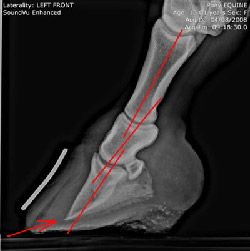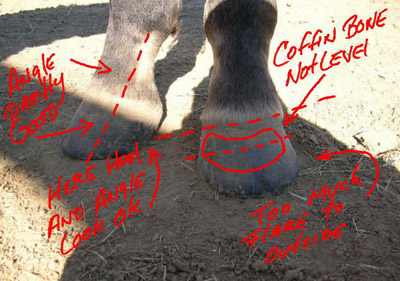.
 Ever worry about lameness to your horse? You should, let me explain why.
Ever worry about lameness to your horse? You should, let me explain why.
Keeping Them Sound
I’m a Farrier in the Bay Area, California for 18 years now; my claim to fame is I haven’t had one single lame horse due to my method of shoeing during those 18 years.
When I graduated horseshoeing school even though I graduated at the top of the class when I walked out the doors I knew (I could just feel it) there was something seriously missing in the education I got there. The school I attended is noted as the “Best in the World”.
Education Doesn’t Stop After Graduation
I got lucky though and immediately went to work on discovering the truth about shoeing and all the critical parts/aspects of shoeing that were left out at the school. I spent years and years photographing before and after pictures of feet I worked on and verified all the nuances and discoveries I made.
Research Pays Off
 Over the years I realized none of the horses I shoe were coming up lame – this was a good thing but interestingly enough some of my clients changed farriers and then frequently I’d get a call back from the old client asking “John will you come out and look at my horse, it’s lame”.
Over the years I realized none of the horses I shoe were coming up lame – this was a good thing but interestingly enough some of my clients changed farriers and then frequently I’d get a call back from the old client asking “John will you come out and look at my horse, it’s lame”.
When I went out to look at the horse, well it was just obvious why the horse was lame; the work in my opinion was terrible – no wonder the horse is lame. How tragic for both horse and owner.
Sharing My Knowledge
Long story short I started realizing people everywhere must be having lameness issues with their horses, so I started blogging about lameness prevention slightly over a year ago.
In a heartbeat I started getting email and responses from people all over the world telling me horror stories about how their horses came up lame from their farrier doing such inferior work.
I would receive photos that shocked me and I started to really realize just how upside down the Farrier industry is and I was saddened knowing how many horses were being ruined and how victimized and at risk horse owners really are. You see if your horse is not lame you’re actually lucky, as most horses are really quite out of balance, and that means even with Farrier care.

Industry Standards Need Updating
There are old school techniques of shoeing that are still taught in the schools and textbooks that farriers practice that simply do not work. Horses are put down “Euthanized” every day due to these faulted practices. It’s really time for this industry to make a change, come up to speed and stop putting horses at risk.
My findings are: approximately 98% of horses are pigeon toed – even if the feet point straight ahead which is considered perfect. One of the problems is the schools and textbooks teach a method of correcting pigeon toes that is going to make matters worse for your horse.
Recipes for Disaster
 And this is just the beginning, there are other industry misconceptions about horse’s feet perpetuated by the schools and textbooks that need to get ironed out.
And this is just the beginning, there are other industry misconceptions about horse’s feet perpetuated by the schools and textbooks that need to get ironed out.
Pigeon toed or toed out horses, if left unattended are flat out at risk of lameness, when Farriers come along and correct these conditions using the old school techniques, matters get worse. These are all recipes for disaster.
What Can You Do?
So what can you do? Well, you can get educated yourself right?
Well that’s hard to do when the schools and textbooks at are at fault in the first place. But don’t worry, I’ve been making all my knowledge of my 18 year study in true balance and lameness prevention available.
My Free ebook
Feel free to leave your name and email address with me and I’ll put you on my priority email list to notify as soon as my ebook “Inside Horseshoeing Secrets of Lameness Prevention” is done.
Very soon, you will be able to preview the ebook, and the best part is, the ebook is free. I’m also still giving consultation at no cost as well; just get a hold of me personally on Care For Horses, or you can find me on twitter @care4horsescom.
Thank you, best wishes and Happy Holidays for ’08
Happy and safe riding and always remember to take care of your horses feet.
John “TheFootDoctor” Silveira

Great post John. My mother’s horse had exactly this problem that was finally solved when the hooves grew out and she found a new farrier. How fortunate for me that YOU are in the Bay Area. When we get horses (soon), you’ll be the man we call.
pleace send me your book
Hi Jeanette,
Thanks for your comment.
You can request John’s book on his website – just follow this link: http://www.care4horses.com/.
My daughters horse is lame 4months and we still dont know why. Desmitis supposedly. Does anyone know a cure.
my horse is currently lame due to a farrier that put the shoe on wrong. my trainer didn’t realize it till i was at the most important show of the year. thanks for the information.